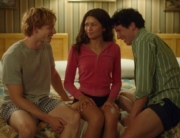A Master Builder is an enthralling deflation of the archetypal egotistical artist, told with delicious irony from his perspective. Henrik Ibsen’s 1892 play Master Builder Solness (to use the full, original title as the film credits do), could be Stanford White (Ibsen’s contemporary) or, a few years later, Frank Lloyd Wright. However, this bullying, preening, predatory old man feels like today’s Masters of the Universe building financial castles in the air. Wallace Shawn’s adaptation (he also stars) has genuine sympathy for his acolytes and victims.
In this intense interpretation, Halvard Solness (Shawn) lies on his death bed, but still controls the people in his orbit by his iron will, as he has for years. He dominates as a talking head surrounded by solicitous nurses. While his wife, Aline (Julie Hagerty), fusses over him, he rejects the ministrations of her unctuous Dr. Herdal (Larry Pine). Others are using this last chance to finally press their own priorities.
His first mentor, and overtaken partner in his architecture practice, Knut Brovik (André Gregory), has now been reduced to a browbeaten elderly employee. Risking his own precarious health, Brovik tries to help his son Ragnar (Jeff Biehl) gain the master builder’s essential endorsement of blueprints for a new client’s house. No matter how much the father and son plead and argue, Solness keeps finding nasty new excuses to withhold approval—whether it’s criticizing Ragnar’s talent or the modern style of his design.
Their work has always been tied up with Solness’s manipulation and control of all of their personal lives, and the dying man triumphantly cackles about how he accomplished this, claiming that he will keep the younger man tethered in order to keep his fiancée and the firm’s bookkeeper, Kaya (Emily Cass McDonnell), as his very private secretary, or else, fire them all.
From his view through his window, Solness supervises his final project, a magnificent mansion whose very location and room design dredges up his wife’s worst, most depressing memories, built on the ashes of her family’s ancestral home. Hagerty is more known for her comic roles in films, but she embodies delicate pathos here.
Just when the master seems too insufferable, along comes a woman who revives him by idolizing him based on his prime days topping off his great tower. The script’s clever change from what seems just male chauvinistic flattery in the original play is to re-imagine Hilde as a fantasy figure. She’s a beautiful embodiment of a kind of Viagra that can get him out of his death bed and onto his feet to be admired—and he’s willing to dump everyone else for his rejuvenation. (A passionate Lisa Joyce makes a big impression in her biggest film role so far.)
She fervidly gets him to remember a day when a young girl’s cheer (hers) stood out from a town’s celebration of his tower, the literal pinnacle of his career, before he settled into designing bourgeois residences, and the impression he made on her when she met him later at a reception. Her narrowing eyes and changing expressions strongly hint at her mixed motives in appearing now, 10 years later.
Director Jonathan Demme has brought stage productions to the screen before, such as Neil Young Trunk Show (2010) and Spalding Gray’s Swimming to Cambodia (1987). But as a tribute to Louis Malle’s classic collaborations with Shawn and Gregory, My Dinner with André (1981) and Vanya on 42nd Street (1994), this is more than a filmed play. For all the talk about architecture, the action takes place in only a couple of rooms, but is not static.
Director of photography (and executive producer) Declan Quinn shot Demme’s Rachel Getting Married (2008) in a similar style. The cinematography combines the same sense for locale (the opening is a beautiful ride past many lovely large houses the master builder presumably designed) and urgent hand-held camera intimacy. As a result, the 360-degree close-ups dispense any stagey feel. In this restoration, everything old is new again.






Leave A Comment